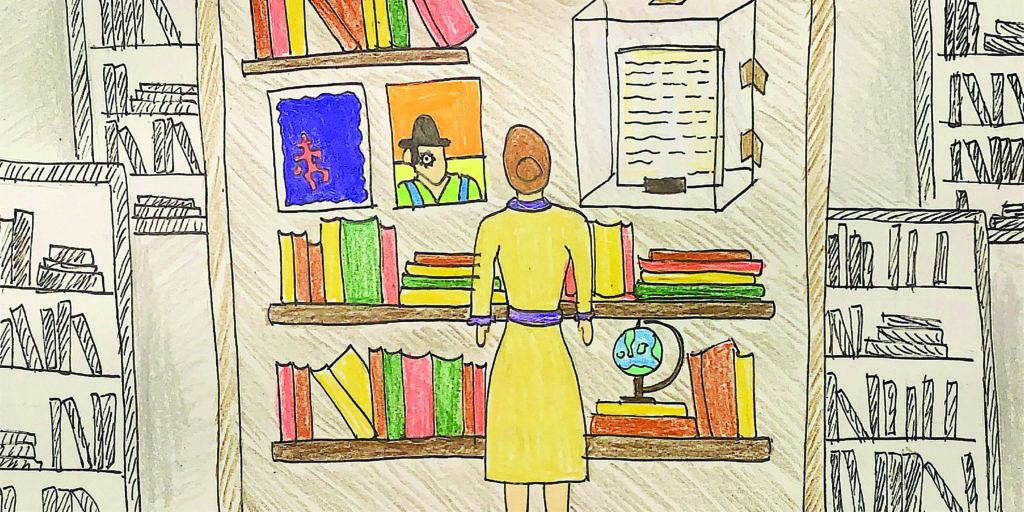Park Avenue was festooned with tulips as we looked for parking on our way to the 62nd annual New York International Antiquarian Book Fair. The Fair was being held this spring, as it is every spring, at the Armory, a neo-Gothic structure that once housed the so-called “Silk Stocking” Seventh Regiment, owing to its location on the affluent East Side of Manhattan (originally at Third Avenue and later at Park between 66 and 67th streets). The building contains a Tiffany Room designed by Stanford White and Louis Comfort Tiffany, carved, painted in the most extravagant fashion, and lately renovated for use for official gatherings and rented parties.
What better site for a collection of priceless books and artifacts from every period of human history? The Fair had been one of my favorite yearly events until the pandemic put my visits to New York City on hold. Now, I was back and so was the Fair, though the Covid years had given it, like everything else, a somewhat different coloration.
If Park Avenue in springtime showcases tulips, the Antiquarian Book Fair showcases less ephemeral but no less colorful samples of material culture: books that are rare, influential, and beautiful; first and special editions; illustrated works by the most august artists; and memorabilia such as movie posters, letters, photographs, and assorted oddities associated with the literary establishment. From the historic and academic to the religious and spiritual to the plainly secular culture of finance and politics, the Fair boasts offerings in every conceivable genre and subject. Walk in and you may initially feel dizzy. What to look at first — which stall, with its curated display of wonders, to peruse? An illuminated manuscript from the Middle Ages, an original George Gershwin score with his notations, a first edition of Jack Kerouac’s On the Road, book cover designs by masters of Cubism, Dada, and Art Nouveau? In other venues, you must get written permission and gloves to handle rare and very old volumes. Here, you casually ask to take a look and it is brought forth for you to handle with no apparent concern for greasy fingers. The vendors wear skinny pants and have excellent haircuts or three-piece suits and bow ties, more or less reflecting the range of materials on display: from young and hip to old and snooty. Many speaking with international accents (France this year seemed to predominate but England was well-represented as was Germany and Japan).
I, for one, am always tempted to buy, though the prices are well outside my price range. Five years ago, I succumbed with the purchase of a first edition of Dickens’s Bleak House, a collection of 19 pamphlets as they had appeared in serial form in 1852-53 in 20 parts(the 19th and 20th parts being combined in one pamphlet). The collected pamphlets (displayed in a handsome book-shaped container) seemed a steal at $2000; after all, there was a first edition of Hard Times (a shorter and less important Dickens novel) in a stall around the corner selling for $10,000. The Bleak House would be a nest egg for prospective grandchildren, I thought. Sadly, I would later discover that some of the front covers of the pamphlets had been replaced, and the pamphlets themselves were more tattered and notated than is required for “good” or even “fair” condition, making the whole worth much less than expected (indeed, perhaps, worth nothing, since the key is to find someone as deranged as myself who would buy such a thing). Still, I have it displayed in its thick cardboard casement on the mantel in the living room and rationalize it as a very high-end conversation piece — about Dickens’s serial publication of his novels and, more amusing to my friends, about my fleecing at the Antiquarian Book Fair.
But to return to this year’s Fair. It is a source of particular excitement to be able to ask the young woman behind the counter to show me the letters by Sylvia Plath to her mother, exceptionally gushing about her soon-to-be-husband-destined to-turn-heel, Ted Hughes. It’s painful to read Plath sounding like a star-struck schoolgirl (which I suppose she was), extolling Hughes’s poetic prowess. Not a word about her own writing. I feel momentary dismay, then retaliatory triumph on her behalf that her poetry, not his, is likely to endure — though I hate to think that to eclipse him she had to do away with herself.
Also capturing my attention is a volume of medical illustrations by Andreas Vesalius, the 16th-century physician and father of the science of anatomy — not a first edition, but a second, an improvement, I’m told, on the first in that it corrected earlier mistakes. The skeletons, based on his forays into human dissection, are posed on the page like macabre super-models. It is an odd and fascinating volume, a reminder of mortality even as it helped physicians prolong human life.
Another stall features a large white plastic valise marked “bag one” in block print and signed in black marker: John Lennon. The vendor explains that this is one of the few intact examples of 25 gifts given out at an event hosted by John and Yoko. He pulls the valise out from the display case, opens it, and shows us that, tucked inside, are a series of lithographs based on sketches by Lennon. Some of these are erotic drawings of Yoko alone or with him. The first in the series is a sketch of the two in bed with photographers opposite, preparing for the iconic 1981 cover of Rolling Stone Magazine in which John, naked, embraces a clothed Yoko in their bed. John’s drawing style is charming; he clearly had talent, and one is reminded that he began as an art student before turning to music.

The vendors, hanging around their stalls all day, are eager to take out a volume and let us finger it, explaining its background if they have information that might be of interest. I find these little lectures delightful. Sometimes a fellow browser knows more about the item than the vendors. Another appeal of the Fair is being able to strike up conversations with knowledgeable strangers about whatever it is you are looking at. Someone fills us in on James Joyce’s revisions of Ulysses and the ups and downs of John Barrymore’s movie career (while inspecting a first edition of the former and a poster for a movie starring the latter). It’s wonderful to be able to move from inspecting the first book on tennis by Antonio Scaino to a 20-volume set of the Complete Works of George Sand to a portfolio of Japanese erotica.
Curiosities aside, what makes the Fair so special is that it is about books. Books with covers and pages have, in a society dominated by social media and other sorts of online detritus, become functionally obsolete.
I recently went into a bookstore in New Haven, Connecticut and was confronted by a bookcase sporting the label: “the Library of Geoffrey Hartman.” Hartman was a venerable literature scholar who spent the majority of his career at Yale. His books, collected on the shelves of this second-hand bookstore, had a poignant appearance. A few gaps in the shelves showed that a volume here and there had been purchased, but mostly the books scowled at me, annoyed by the likelihood that they would remain on these shelves in perpetuity. A memento mori, one could say, for the way in which reputations fade but also of how expendable not just the individual but the individual library is these days. There are, of course, exceptions, like that of the J.P. Morgan Library in New York City and the Rosenbach Library in Philadelphia, though, in these cases, enormous wealth puts the collections in a different sphere. Very rich people could collect works that were already rare and place them in opulent settings. Without such trappings, a motley collection of German, French, Hebrew, and English academic texts are bound to languish.
Perhaps the term “antiquarian,” which traditionally referred to old, valuable books, often first editions and manuscripts, now seems to me to apply to all books. Books, by definition, have become, if not antiquarian, antiquated in their material form. They have become artifacts.
I have hundreds of books on my Kindle, given that my eyes seem to get worse every year. I appreciate the bright screen and the ability to change the size of the font as needed. These books exist as bright postage stamp items on the Library Page of the app, while the books on the shelves of my apartment become more and more dated and dust-covered each year. It seems indulgent to buy more, since, once read, they are rarely read again and simply take up more space and gather more dust. Still, a room without books would not feel like home. It would hardly feel like a room. Which is why, perhaps, the magnificent books at the Fair seem to be attracting buyers.
Indeed, one could argue that even books that are not in themselves valuable, have begun to have acquired an “aura.” This is the term used by the literary critic Walter Benjamin (no doubt a major figure in Geoffrey Hartman’s library) whose “Work of Art in the Age of Mechanical Reproduction” is a classic contribution to cultural theory. Benjamin posited that art — original art — was linked to a particular time and place so that it had an aura associated with the hand of the artist. If the artist became famous, this explained the high prices that accrued to their original work. Work that was not original — i.e., posters and reproductions — lacked that aura. The same could be said for books, meant to be reproducible by definition. Unlike original manuscripts, printed volumes, by being mass-produced and separated from the hand of the artist, carried no aura.
But this may have changed. We have arrived at a new age in which mechanical reproduction has been largely replaced by digital reproduction. As a result, the material book becomes rarer and more important; it acquires the “aura” attached to its materiality. This materiality — and its accompanying beauty — shines brighter in being under siege by computerized versions of itself.
I suspect that in a generation or two, to walk into a home with bookshelves filled with books will be akin to walking into a home with original art on the walls. Both will be rare occurrences — even if the art is not by an old master or even if the books are not first editions or even classics. Their material presence on the shelves will provide aura enough.•




